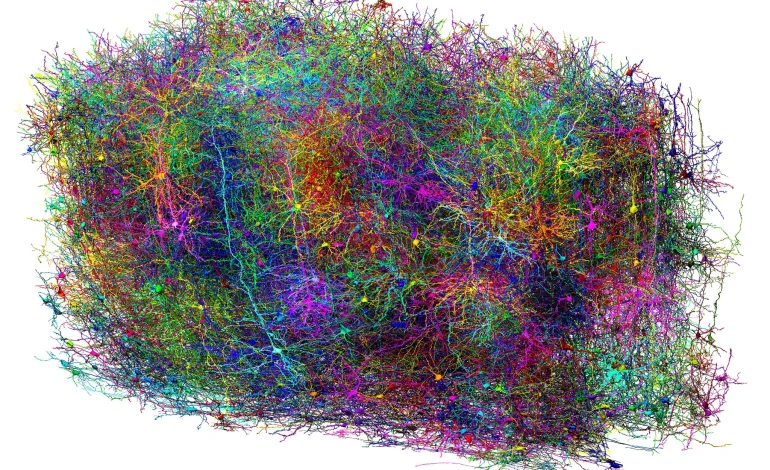A team of over 100 scientists has accomplished what was once considered unattainable: mapping the activity and structure of 200,000 cells in a cubic millimeter of a mouse’s brain, along with their 523 million connections, the New York Times reports.
This milestone, published in Nature, marks a significant advancement in neuroscience and could pave the way for a deeper understanding of the brain’s complex wiring.
In 1979, Nobel Prize-winning scientist Francis Crick famously declared that the structure and activity of even a tiny fragment of brain tissue would forever exceed human understanding.
“It is no use asking for the impossible,” he wrote.
Yet, nearly five decades later, researchers have achieved precisely what Crick deemed unattainable.
The effort, known as the Machine Intelligence from Cortical Networks (MICrONS) project, began in 2016 as part of a $100 million US government initiative to better understand the brain’s intricate structure. Led by the Allen Institute for Brain Science, Princeton University, and Baylor College of Medicine, the project focused on a small region of the mouse brain that processes visual information.
The research team recorded the neural activity of a live mouse as it watched video clips, then carefully preserved and dissected the brain. Using advanced imaging techniques, they shaved the tissue into 28,000 ultra-thin slices and captured high-resolution images of each layer. Cutting-edge computer algorithms then reconstructed the data into a three-dimensional map, revealing a vast and intricate network of neurons.
In total, the team accumulated 1.6 petabytes of data—equivalent to 22 years of nonstop high-definition video. The findings offer a detailed look at how different types of neurons connect and interact, shedding light on long-standing mysteries about brain function.
For over a century, scientists have known that neurons communicate by sending electrical signals along axons, which connect to other neurons’ dendrites. Some neurons excite their neighbors, triggering further activity, while others inhibit signals to maintain balance. However, understanding how this interplay gives rise to thought, perception, and behavior has remained elusive.
One particularly striking discovery in the MICrONS study was the identification of specific inhibitory neurons, such as Martinotti cells, which regulate the activity of neighboring neurons in previously unknown ways. These findings suggest that the brain’s wiring follows more structured patterns than previously thought.
“When you go into studying the brain, it seems kind of hopeless—there are just so many connections and so much complexity,” said Mariela Petkova, a biophysicist at Harvard who was not involved in the project. “Finding wiring rules is a win. The brain is a lot less messy than people thought.”
While this achievement is groundbreaking, it represents only a fraction of what remains to be done. A full mouse brain is 500 times larger than the section mapped in this study, and mapping an entire human brain—about 1,000 times larger—remains an even greater challenge.
Many MICrONS researchers are now contributing to an even more ambitious goal: mapping the entire mouse brain. However, using current methods, this process could take decades. Scientists are now developing new technologies to accelerate progress, with hopes of completing the project within ten years.
“This is totally doable, and I think it’s worth doing,” said neuroscientist Davi Bock of the University of Vermont, who was not involved in the MICrONS project.
Despite these promising advancements, the future of large-scale brain mapping remains uncertain. The US government’s BRAIN Initiative has provided crucial funding, but recent budget cuts threaten to slow progress. Last year, Congress reduced funding for the program by 40%, with additional cuts of 20% implemented this year.
Forrest Collman, a neuroscientist at the Allen Institute, remains optimistic. He and his colleagues have developed new methods to create ultra-thin slices of entire mouse brains, removing one of the biggest technical hurdles.
“The barriers are starting to fall,” Collman said.
However, mapping the human brain remains far beyond current capabilities.
“The human brain right now feels outside the range of what is possible,” he added. “We are not going there anytime soon.”
Even so, experts believe that breakthroughs in mouse brain mapping could have profound implications for human medicine. More precise knowledge of neural connections could lead to better treatments for neurological disorders and mental health conditions, potentially reducing harmful side effects of current medications.
“Our current methods of manipulating the nervous system are incredibly blunt instruments,” said Sebastian Seung, a neuroscientist at Princeton University. “But being able to actually reach in and manipulate a cell type—that’s precision.”










The latest news in your social feeds
Subscribe to our social media platforms to stay tuned